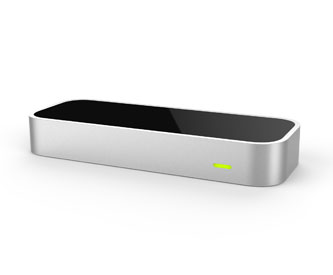 My Leap Motion arrived today. I’ve been working with a development version of the hardware for a couple of months now but I was excited to see what improvements the retail version brought. Other than the obvious aesthetic differences (I’m a fan of the brushed aluminium look!), the retail version has a wider field of view. While this doesn’t affect use of the device much, it does mean that it’s less likely to lose sight of your hands when you move too far away whilst close to the desk. Based on the diagnostic visualiser, it also seems to be more accurate and deals with hand rotation better (although this is likely a software rather than hardware improvement).
My Leap Motion arrived today. I’ve been working with a development version of the hardware for a couple of months now but I was excited to see what improvements the retail version brought. Other than the obvious aesthetic differences (I’m a fan of the brushed aluminium look!), the retail version has a wider field of view. While this doesn’t affect use of the device much, it does mean that it’s less likely to lose sight of your hands when you move too far away whilst close to the desk. Based on the diagnostic visualiser, it also seems to be more accurate and deals with hand rotation better (although this is likely a software rather than hardware improvement).
Having tried some of the apps in the Airspace app store I’m surprised at the large variety of pointing and selection mechanisms being used by developers. Using the finger as a pointer to control the cursor seems easy enough (although it quickly becomes fatiguing after extended periods!), and most developers seem consistent in how they implement this. Getting the control:display gain correct is going to be a key challenge, as some apps require only the most subtle of finger movements to send the cursor flying accidentally. Smoothing the cursor position (e.g. using a Kalman filter) would help to deal with cursor jitter and unexpected movement.
There are a variety of selection methods being used, including finger poke and tap (two gestures recognised by the base SDK), dwell, and opening the hand. The latter selection gesture is used in the Jazz Hands game and works surprisingly well. While pointing to control a cursor, the user can make a selection by opening their hand up. While there is a little inadvertent movement of the cursor as a result of the gesture, it doesn’t require any direct movement of the pointing finger.
I’m not a fan of the poke and tap gestures but that might just be because I’ve yet to try a good implementation of them. I’ve implemented my own recogniser for tap gestures a couple of weeks ago and know how challenging it can be to get it feeling “right”.
Dwell selection is generally very accurate and I think that this is going to be one of the best selection methods for Leap going forward. This is largely because it allows the user to leap into an app (a terrible pun, I know) without having to figure out how to make selections. The immediacy of the visual feedback makes it obvious that by remaining over a button, something is taking place.
I’m excited about the future of Leap and other gesture interfaces because they offer the potential to create new ways of interacting with computers. It’s not the future, but it’s a step in the right direction.